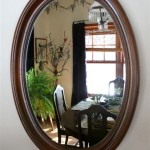The Enduring Appeal of the Wall Leaning Mirror
The wall leaning mirror, a seemingly simple decorative element, has transcended fleeting trends to become a staple in interior design. Its enduring popularity stems from its versatility, functionality, and ability to enhance the aesthetic appeal of various spaces. Unlike traditional wall-mounted mirrors, the leaning mirror offers a less permanent installation solution while providing a significant visual impact. This article will explore the various aspects of the wall leaning mirror, including its benefits, design considerations, selection criteria, and placement options.
The fundamental concept of a wall leaning mirror involves a large mirror designed to lean against a wall at a slight angle. This leaning posture does not only provide a full-length reflection but also creates a sense of spaciousness and light within a room. The mirror's frame, typically constructed from wood, metal, or synthetic materials, plays a crucial role in defining its style and complementing the existing décor. The size, shape, and finish of the frame directly influence the overall aesthetic impact of the mirror.
Advantages of Choosing a Wall Leaning Mirror
One of the primary advantages of a wall leaning mirror is its ease of installation. Unlike wall-mounted mirrors, which require drilling and precise measurements, a leaning mirror can be set up with minimal effort. This makes it an ideal choice for renters or individuals who prefer not to make permanent alterations to their walls. The mobility of the leaning mirror also allows for easy repositioning and experimentation with different layouts. This flexibility is particularly beneficial for those who enjoy rearranging their furniture or adapting their décor to changing seasons or styles.
Furthermore, wall leaning mirrors offer a significant optical illusion, creating the perception of a larger and brighter space. By reflecting light and extending visual boundaries, these mirrors can transform small or dimly lit rooms into more inviting and spacious environments. The strategic placement of a leaning mirror can effectively double the perceived size of a room, making it a valuable tool for interior designers and homeowners alike. The reflective properties also contribute to enhancing natural light, reducing the need for artificial illumination during the day and creating a more energy-efficient living space.
Beyond its practical benefits, the wall leaning mirror serves as a striking decorative element. Its presence can elevate the overall aesthetic of a room, adding a touch of elegance and sophistication. The variety of styles available, ranging from minimalist and modern to ornate and vintage, ensures that there is a leaning mirror to suit every taste and décor preference. The frame of the mirror can be chosen to complement existing furniture, artwork, or architectural details, creating a cohesive and harmonious interior design scheme.
The perceived height of a room can also be modified with the use of a tall leaning mirror. By drawing the eye upwards, these mirrors create the illusion of higher ceilings, making a room feel more open and airy. This is particularly useful in rooms with low ceilings, where a leaning mirror can help to counteract the feeling of confinement. The vertical lines created by the mirror contribute to a sense of verticality and spaciousness.
Design Considerations
When selecting a wall leaning mirror, several design considerations should be taken into account to ensure that it complements the existing décor and serves its intended purpose. The size of the mirror should be proportional to the size of the room. A large mirror in a small room can be overwhelming, while a small mirror in a large room may appear insignificant. The mirror's dimensions should be carefully considered in relation to the surrounding furniture and architectural features.
The style of the mirror frame should also be consistent with the overall design aesthetic of the room. A modern or minimalist room may benefit from a sleek, frameless mirror or one with a slim metal frame. A more traditional or ornate room may call for a mirror with a decorative wooden frame. The finish of the frame should also be carefully chosen to complement the existing color palette and materials used in the room.
The shape of the mirror is another important design consideration. Rectangular mirrors are the most common and versatile, but oval, round, or irregular shapes can add a touch of individuality and visual interest. The shape of the mirror should be chosen to complement the shape of the room and the surrounding furniture. For example, a round mirror can soften the hard lines of a rectangular room, while a rectangular mirror can emphasize the verticality of a room with low ceilings.
The placement of the mirror is crucial to its effectiveness. It should be positioned in a location where it can reflect light and create the illusion of spaciousness. Ideally, the mirror should be placed opposite a window or a source of natural light. This will maximize the amount of light reflected into the room, making it feel brighter and more inviting. The mirror should also be positioned to reflect a pleasant view or a focal point in the room, such as a piece of artwork or a decorative element. Avoid placing the mirror in a location where it will reflect clutter or an unattractive view.
Selecting the Right Wall Leaning Mirror
The selection of a suitable wall leaning mirror involves careful assessment of various factors, including size, style, material, and safety features. The size of the mirror should be determined by the available space and the desired effect. It's important to measure the area where the mirror will be placed to ensure that it fits comfortably and does not overcrowd the room. Consider the height of the ceiling and the overall proportions of the room when choosing the size of the mirror.
The material of the frame should be durable and aesthetically pleasing. Wood frames offer a classic and warm look, while metal frames provide a more modern and industrial feel. Synthetic materials, such as resin or plastic, can be a more affordable option, but they may not be as durable or visually appealing as natural materials. The finish of the frame should be chosen to complement the existing décor and color palette of the room. Consider the maintenance requirements of different materials when making your selection.
Safety is a paramount concern when choosing a wall leaning mirror. The mirror should be made of high-quality glass that is resistant to shattering. Tempered glass is a safer option, as it breaks into small, relatively harmless pieces if it is shattered. The frame should be sturdy and well-constructed to prevent the mirror from tipping over. Consider using safety clips or brackets to secure the mirror to the wall, especially in homes with children or pets. Inspect the mirror for any cracks or defects before purchasing it. Leaning mirrors should ideally come with a non-slip backing or grips to minimize the risk of them moving or sliding.
The quality of the reflective surface is also important. Look for a mirror that provides a clear and distortion-free reflection. Some mirrors may have a slight tint or distortion, which can affect the way you see yourself. Test the mirror by standing in front of it and observing your reflection from different angles. The mirror should accurately reflect your image without any warping or distortion. Consider the lighting in the room when evaluating the quality of the reflection. The mirror should perform well under different lighting conditions.
Finally, consider the budget when selecting a wall leaning mirror. Prices can vary widely depending on the size, style, material, and quality of the mirror. It's important to set a budget before you start shopping and to compare prices from different retailers. Keep in mind that a higher price does not always guarantee better quality. Read reviews and do your research to ensure that you are getting the best value for your money.
In conclusion, the wall leaning mirror represents a timeless and versatile decorative element capable of enhancing the aesthetics, functionality, and perceived spaciousness of any interior. The successful integration of a leaning mirror hinges on careful consideration of size, style, material, safety, and placement, ensuring a harmonious complement to existing décor and a visually appealing outcome.

Mirror The Arcus Frameless Arched Leaner Wall 74 X 33 190cm 85cm Diy At B Q

The Perfect Leaning Mirror April 2024 Your Guide To 9 And Floor Mirrors

How To Secure A Leaning Mirror The Wall Diy Playbook

How To Build Large Floor Leaner Mirror Sawdust 2 Stitches

Yearn Delicacy Arched Wood Frame Wall Leaner Mirror Gold 150 X 60cm

Leaning Pictures And Mirrors The Easy Alternative To Hanging Art

Kingsbury Full Length Mirror Antique Silver 61cm X 150cm Mirrors Exclusive

Curved Wall Or Leaning Mirror The Forest Co

Floor Length Mirrors Chunky Leaning Big Mirror In Bedroom Decor

Leaning Mirrors At Com








